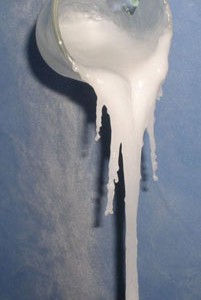Gelling, What It Is and What to Do About it
| Diesel Fuel contains paraffin wax in two forms, liquid wax that is in suspension in the fuel and wax seed crystals that are floating throughout the fuel. In temperatures above the fuels Cloud Point (CP) you can’t see wax without a microscope. When fuel reaches its Cloud Point wax in the fuel has begun attaching itself to the wax crystals making them large enough to be seen with the naked eye. This wax will appear as a cloud-like formation floating in the fuel.As the fuel temperature drops the wax crystals continue to get larger and will begin to stick to each other. At this Cold Filter Plug Point (CFPP) or Gel Point the fuel will have difficulty passing through fuel filters. This is the critical point at which it can become difficult or impossible to operate an engine or burner.As the temperature continues to drop the fuel can become a semi-solid, this is known as the Pour Point (PP), or the point at which fuel will no longer pour.
You can prevent from fuel from gelling in three ways.
Number one can be difficult if not impossible, number two can be very expensive and with the New Ultra Low Sulfur Diesel is no longer reliable; it can require so much of a special Ultra Low Sulfur Kerosene as to be impractical. Number three can be done reliably and inexpensively and is the best way to deal with these issues. Cold Flow Improvers or Anti-gel are a co-polymer that coats the paraffin wax crystals normally found in all diesel fuels to prevent the wax crystals from getting any larger and to prevent them from sticking to each other (gelling). This anti-gel material is quite thick and must be blended with solvents to allow it to be mixed properly with fuels. It is important to understand that even anti-gels blended with solvents will thicken at temperatures below 40°F. Fuel additives containing anti-gel should be stored above 40°F. If stored below 40°F allow them to warm up before adding them to the fuel. An analogy of what happens to anti-gel is what happens with coolant antifreeze. By itself, antifreeze will thicken in cold weather to the point of being nearly solid, but when mixed with the correct amount of water it will prevent freezing to -40°F or more. Anti-Gel’s work in a similar way, when mixed with the correct amount of fuel they effectively prevent gelling, lowering the gel point by as much as 35°F. Another important thing to remember about anti-gel additives is that you have to treat the fuel before it begins to gel. Products such as Complete Fuel Treatment™ are preventatives designed to prevent gelling, once the fuel has gelled anti-gels won’t help you until the fuel has thawed. If someone tells you they have an anti-gel additive that does not thicken when cold you should know and understand that there are two types of additives that don’t have this problem, one doesn’t actually contain any anti-gel, the other contains a smaller amount of antigel with large amounts of alcohol to prevent thickening. Alcohol is about the worst thing to put in an additive. |
What to Do!When you have fuel that is gelled, there are only two choices. One warm the fuel up, generally done by dragging the piece of equipment into a garage, or two by using a product such as Thaw-It™ to dissolve the wax and reliquefy the fuel. Thaw-It™ contains two co-solvents to break down waxes in diesel and glycerin’s in biodiesel. Thaw-It™ will also remove (disperse) liquid and dissolved water in the fuel and fuel system.
What NOT to Do!Using gasoline, ethanol, isopropyl, or methanol is dangerous as it lowers the Flash Point of the fuel and will likely damage pumps and or injectors.
How to Use Thaw-It™Remove filter and replace if possible with a new one. If you must use the old filter try to pour out as much of the ice or gelled fuel as possible. Fill the filter with 50% Thaw-It™ and 50% diesel fuel. (Do not fill with 100% Thaw-It™). Add 1 quart of Thaw-It™ per 50 gallons of fuel to the fuel tank(s). Allow to sit for 20-30 minutes, then start engine. Allow engine to warm before driving or operating. Use Complete Fuel Treatment™ or Polar Flow™ to prevent fuel from gelling in the future. If you have water in your fuel system use EnerFuel to disperse water. |


